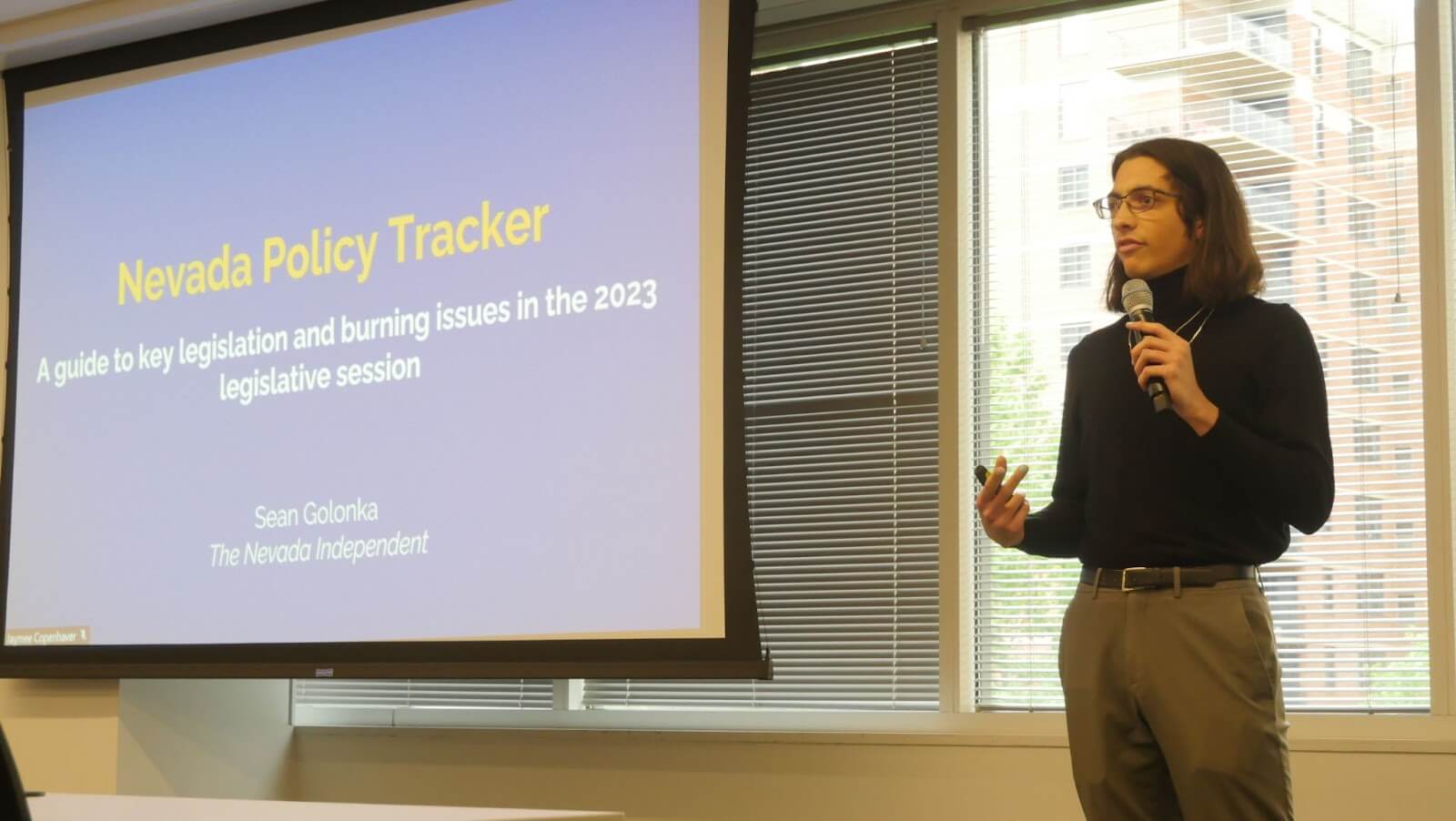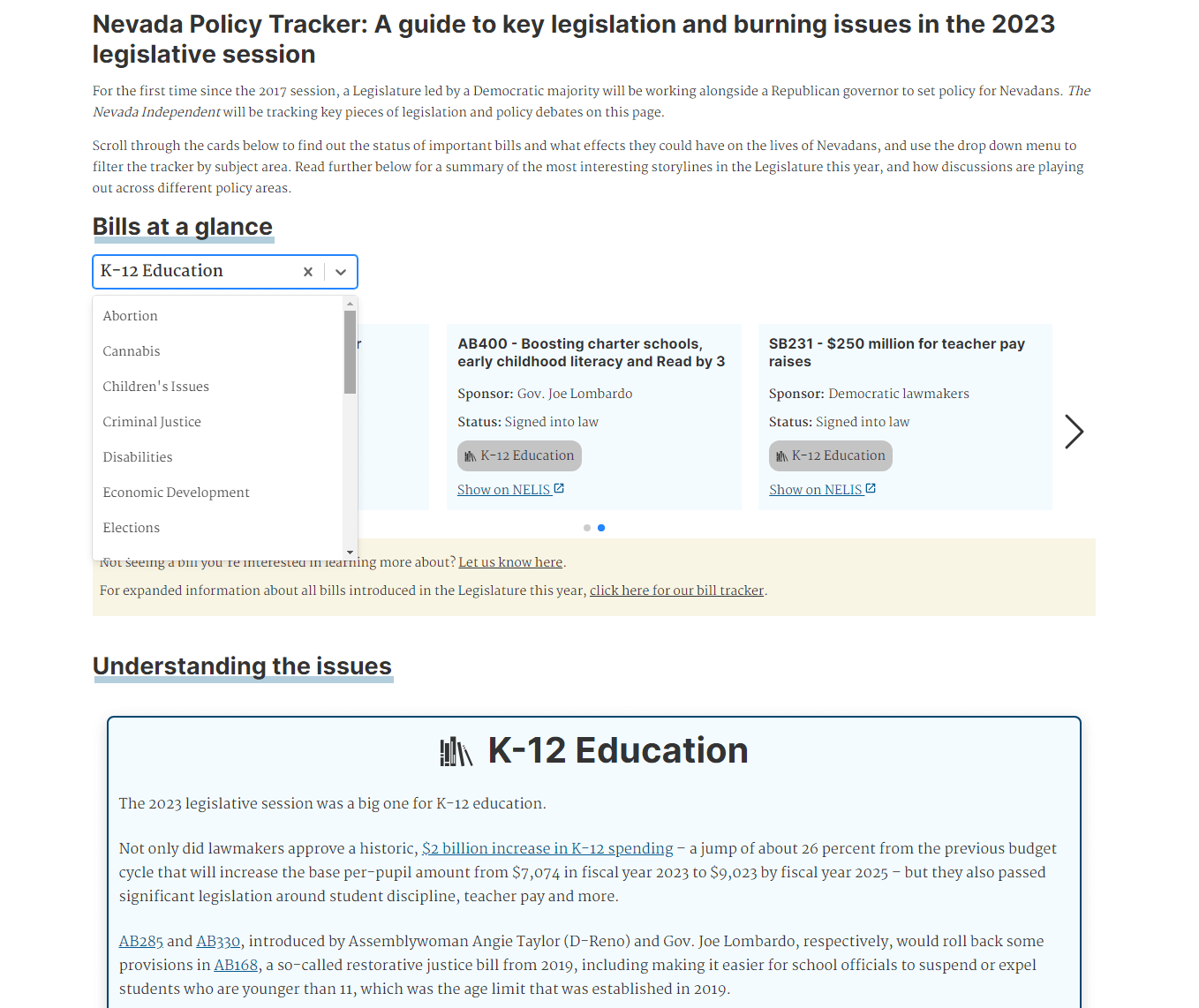A state legislative session is an unwieldy beast for even an experienced reporter to cover. They are full of scaly moving parts, unpredictable special sessions taking place after its over, and wildly different interpretations of bills-in-progress, which are often written in impenetrable legalese.
Imagine how difficult that political maze must be to navigate and understand for residents who’ve never visited a state capitol or read a bill.
Making sense of the legislative session has been the goal of the Nevada Policy Tracker, a web page created by The Nevada Independent, a nonprofit news site that launched in 2017. Sean Golonka, a politics and data staff reporter at the Independent, kept busy covering the 2023 legislative session in Nevada. When it came time to choose an innovation project as part of his Poynter-Koch Media and Journalism Fellowship, he decided to focus on expanding and beefing up the tracker. That would include more bill summaries, a spreadsheet accessible to the public to track specific bills that needed to be filled in manually, and helping improve the tracker’s design to make it easier to use.
“I spent some time sketching out some of the design and connecting with another reporter on the legislative team to talk through, ‘What do we want this to look like, how do we want it to feel and what kind of user-friendly elements can we implement?’” Golonka said. A drop-down menu now allows readers to quickly get to legislative topics such as abortion, higher education, guns, tax policy, or just a catch-all “key bills.”
Through the session and the two special sessions that followed, reporters wrote summaries in easy-to-digest language so that readers could stay abreast of the progress of bills. The tracker explained the real-world impact of what the bills would do, who was sponsoring those bills, and what chance they had of passing. A post-session summary explained the major happenings that came out of the 2023 legislature.
“There’s all these policy dynamics that happen in every legislative session … it’s so broad and so much to handle for regular people who may just want to understand what’s happening in their state government,” Golonka said. “The thinking was how do we boil down each kind of category of issue into the simplest way so folks can understand it?”

Sean Golonka, a politics and data reporter at The Nevada Independent, presents his innovation project at a May summit for the 2022-2023 Poynter-Koch Media and Journalism Fellowship in Washington, D.C. The project included fleshing out and adding new features to the publication’s policy tracker, making it easier for readers and staff to keep track of the status and potential effects of bills in the Nevada legislature. (Photo: Gil Asakawa)
In addition to servicing readers, the tracker also helps reporters and editors at the Independent follow the progress of legislation and will serve as an important resource when lawmakers return for the next session, scheduled for February 2025. The searchable 2023 tracker will still exist on the site even as a new one is built for that session.
“It’s a helpful resource just for referring back to what happened in the 2023 session; it captures all of those different policy angles and makes it easy to refamiliarize yourself even if you’re a year or two past the session,” Golonka said.
Golonka worked with the publication’s chief technology officer on the backend and the tracker is designed specifically for the Independent, but the reporter says that other publications could make something similar if they haven’t already built out tools to cover the legislature in this way.
“Certainly the bones of it and the structure could be easily implemented in another newsroom as long as they’re willing to have reporters work to put together this type of information,” he said. Some of the work Golonka did to enter information into the spreadsheet could be more automated depending on data availability from a state’s government and the tools available to collect and sort that data, he said.
Another focus of the last session was to add more topic categories to the tracker, specifically areas related to underserved communities. The summaries are meant to explain the impact certain bills would have on citizens’ lives and whether those laws came to pass.
The tracker, Golonka said, is helping journalists get closer to their communities. “The system,” he said, “allows us to lean on our different beat reporters who might be closer to an issue and have a better understanding to summarize, to find the most helpful nuggets of information, and relay that information to the public.”
This story is part of a series profiling innovation projects from the 2022-2023 Poynter-Koch Media and Journalism Fellowship. The projects were presented at a May summit in Washington, D.C.






